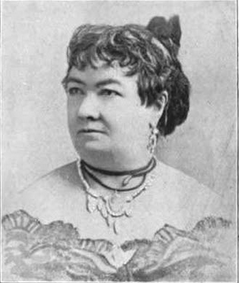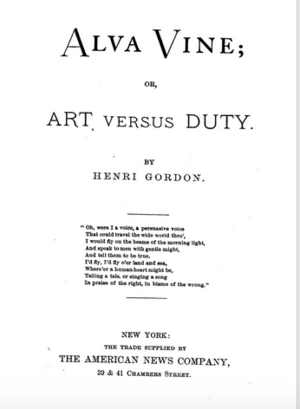Clara M. Brinkerhoff facts for kids
Quick facts for kids
Clara M. Brinkerhoff
|
|
|---|---|
 |
|
| Born | Clara Maria Rolph 8 September 1828 London, England |
| Pen name | Henri Gordon |
| Occupation | Singer, romance novelist |
| Language | English |
| Genre | opera |
| Spouse |
Charles E. L. Brinkerhoff
(m. 1848) |
Clara Maria Brinkerhoff (who also used the name Henri Gordon) was an amazing American singer and music teacher. She was born on September 8, 1828. Even as a child, her beautiful voice impressed many people. Her father didn't want her to be a professional singer. So, she only sang in concerts sometimes when she was young.
When she was 17, she married Charles E. L. Brinkerhoff. For a few years, she didn't perform in concerts. This was out of respect for her husband's family. Later, her manager, Theodore Eisfeld, convinced her to sing again. Critics said her voice was incredible and very powerful. She could sing many different types of music. She was excellent in oratorios (large musical works) and felt at home singing opera. Clara also helped invent a special telegraph key.
Contents
Clara M. Brinkerhoff: A Talented Singer and Inventor
Her Early Life and Musical Training
Clara Maria Rolph was born in London, England, on September 8, 1828. Her parents, Mr. and Mrs. John A. Rolph, moved to the United States around 1834 or 1835. Her father was an artist who specialized in steel engraving. Clara's mother was also artistic and musical. She had a wonderful singing voice. Her mother trained Clara in singing from age five to twelve.
After her mother passed away, Clara continued her music lessons. She studied with Henry Derwort. He wanted her to become a grand opera star. But Clara respected her mother's wishes and did not pursue an opera career. She then studied with other teachers. These teachers helped her prepare for her first public concert. She also learned about oratorio music.
A Career in Music and Beyond
Clara made her first public performance at age 16. It was a concert in Apollo Hall on Broadway in New York City. She was very successful! In her first year, she sang important parts in several famous musical works. These included The Seven Sleepers and Judas Maccabaeus. She later performed in Elijah and Stabat Mater. She also sang classical music by composers like Beethoven and Mozart. She gave many vocal concerts in New York City and other places. She planned and performed these concerts herself.
Clara was the main soprano singer at Grace Church when she got married. She sang the full Christmas service on her wedding day! She married Charles E. L. Brinkerhoff on December 25, 1848. She sang in concerts across the United States and even in other countries. In 1861, she visited Europe. There, she met famous musicians like Auber. He allowed her to attend all the singing classes at the Paris Conservatoire. This helped her study different teaching methods. She was asked to sing in grand opera in Paris, but she still said no. Clara knew the singing styles of English, French, German, and Italian schools. Her voice was a rich soprano that could sing nearly three octaves (a very wide range!).
Teaching Music and Inventing
Clara Brinkerhoff lived in New York City. She was one of the first people to teach basic music and sightsinging in the city's public schools. She taught a class of 300 girls at the Thirteenth Street School. She was very proud of this work. She showed that it was possible to teach music to large groups of children using a blackboard.
Besides singing, Clara was also a composer. She wrote several songs. One of her songs, "One Flag or No Flag," sold many copies during the American Civil War. She also gave talks about technology. Clara was a talented writer too. She wrote a romance novel called Alva Vine: Art Versus Duty. She published it under the name "Henri Gordon." In 1882, Clara and George Cumming invented and patented an award-winning telegraph key. They even started a company called Cumming & Brinkerhoff to sell their invention.
Her Family Life
Clara's husband, Charles E. L. Brinkerhoff, passed away on July 11, 1900, at age 78. He was of Spanish descent. Their only child, a son named Charles Rolph, had passed away several years before his father.
Her Creative Works
Books and Songs
- Alva Vine; or, Art versus Duty, 1880
Musical Scores
- The nation's hymn, 1865
- Clarita : romanza, 1864
- Love, 1854
- On flag or no flag, 1864
- Annie Laurie, between 1858 and 1875



